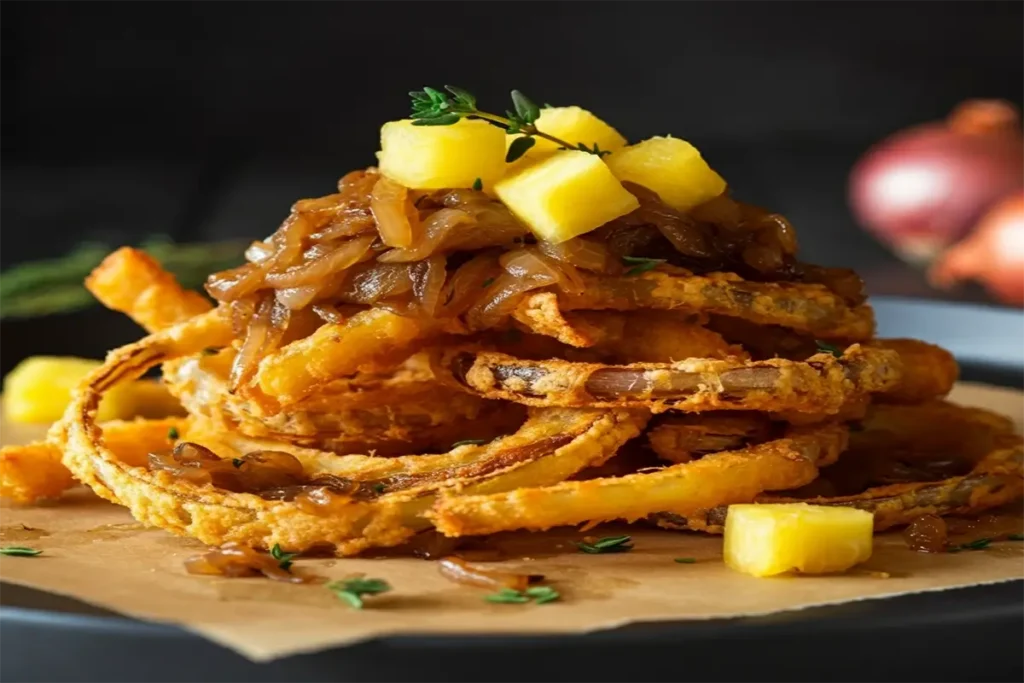Introduction
Do you remember that delightful crunch, that savory onion-infused flavor bursting in your mouth with every bite of perfectly golden, crispy fries? Perhaps it was a memorable diner experience, a cherished childhood memory, or simply a craving you can’t shake. Whatever the spark, recreating that magic at home is easier than you think. This comprehensive guide unveils the secrets to crafting restaurant-quality crispy onion French fries right in your kitchen. Prepare to embark on a culinary adventure that will tantalize your taste buds and leave you feeling like a true fry master.
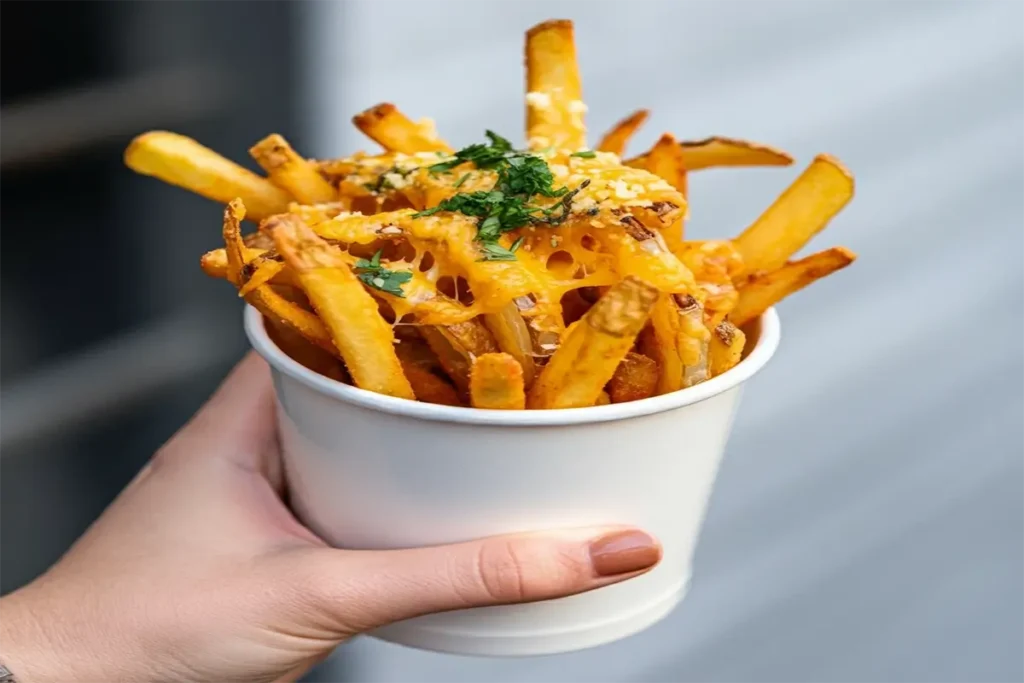
Table of Contents
Onion French Fries
Gathering Your Arsenal: Ingredients for Crispy Onion French Fries
Before you dive into this culinary adventure, ensure your kitchen is stocked with the necessary ingredients. This recipe calls for simple, readily available components that transform into a symphony of flavors and textures. Here’s what you’ll need:
| Ingredient | Quantity | Why It Matters |
|---|---|---|
| Russet Potatoes | 2 large | Russets are the gold standard for French fries due to their high starch content, which translates to a fluffy interior and crispy exterior. |
| Yellow Onion | 1 medium | Yellow onions offer a balanced sweetness and pungency that complements the potatoes perfectly. |
| All-purpose Flour | 1/4 cup | Flour helps create a light, crispy coating that adheres beautifully to the fries. |
| Cornstarch | 1/4 cup | Cornstarch contributes to extra crispiness and helps prevent the fries from becoming soggy. |
| Paprika | 1 teaspoon | Paprika adds a subtle smokiness and vibrant color to the fries. |
| Garlic Powder | 1 teaspoon | Garlic powder enhances the savory notes and adds a depth of flavor. |
| Salt | 1 teaspoon | Salt is essential for seasoning and bringing out the natural flavors of the ingredients. |
| Black Pepper | 1/2 teaspoon | Black pepper adds a touch of warmth and complexity. |
| Vegetable Oil | 3 cups | Vegetable oil is ideal for frying due to its high smoke point and neutral flavor. |
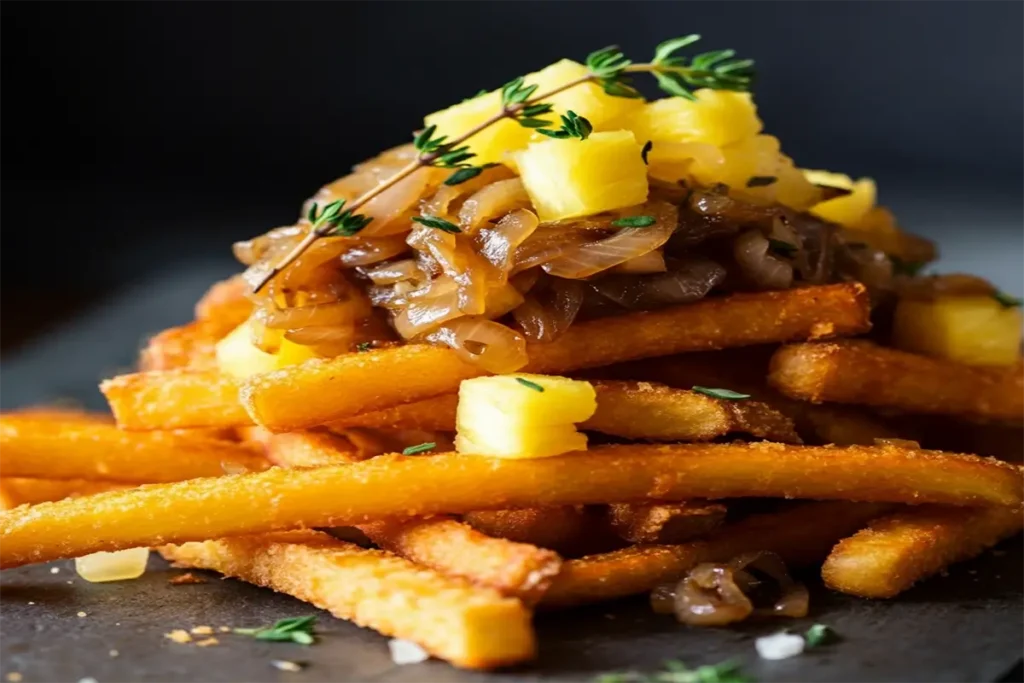
Crafting Culinary Masterpieces: Step-by-Step Instructions
Now that you have your ingredients assembled, let’s embark on the step-by-step journey to crispy onion French fry perfection. Follow these instructions carefully, and you’ll be well on your way to creating fries that rival your favorite restaurant’s.
Prep the Potatoes
Begin by thoroughly washing and peeling the russet potatoes. Cut them into French fry shapes, aiming for a thickness of about ½ inch. This ensures even cooking and a pleasant texture. Once cut, submerge the potato sticks in a bowl of cold water for at least 30 minutes, or even overnight. This crucial step removes excess starch, a key factor in achieving ultimate crispiness.
Onion Magic
While the potatoes soak, turn your attention to the onion. Thinly slice the yellow onion, aiming for slices as thin as possible. The thinness of the onion slices is directly proportional to their crispiness, so strive for delicate slivers that will become wonderfully crunchy during frying.
Dry and Coat
After the potatoes have soaked, drain them thoroughly and pat them completely dry with paper towels. Excess moisture is the enemy of crispiness, so ensure they are as dry as possible. In a large bowl, combine the all-purpose flour, cornstarch, paprika, garlic powder, salt, and pepper. This blend of dry ingredients will form the flavorful and crispy coating for your fries. Add the dried potatoes and sliced onions to the bowl and toss them gently until they are evenly coated with the mixture.
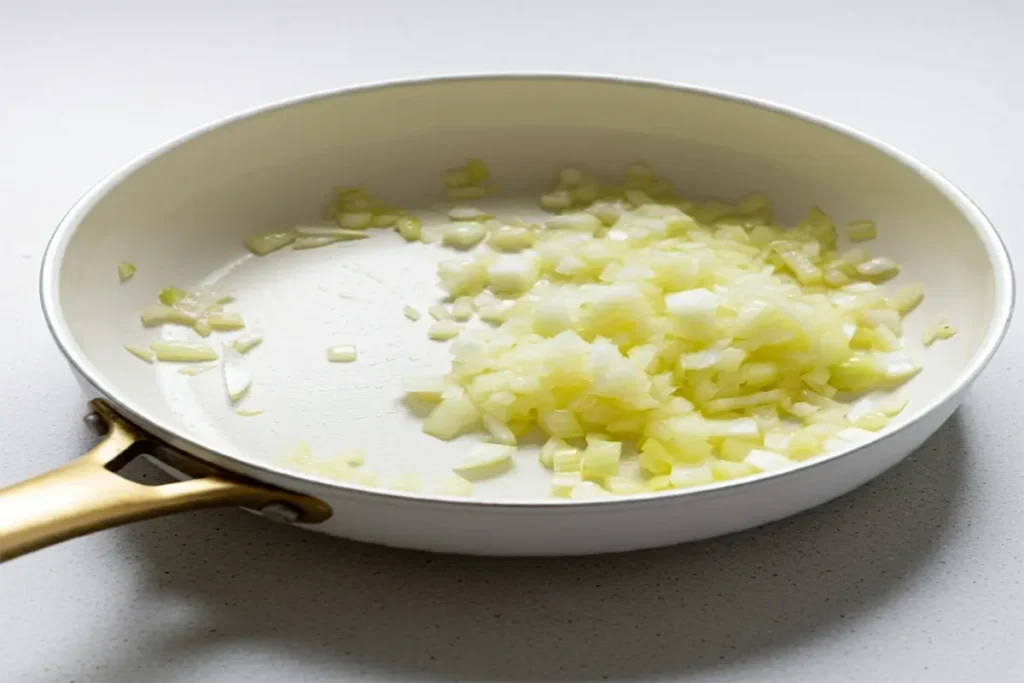
First Fry – The Foundation
In a large pot or deep fryer, heat the vegetable oil to 325°F (160°C). Use a kitchen thermometer to ensure the oil reaches the correct temperature. Carefully add the coated potatoes and onions to the hot oil in batches, being mindful not to overcrowd the pot. Overcrowding lowers the oil temperature, leading to soggy fries. Fry the potatoes and onions for 4-5 minutes in this initial stage, just until they are slightly softened but not browned. This first fry cooks the potatoes through and sets the stage for the ultimate crispy exterior. Remove the fries from the oil and place them on a wire rack to drain.
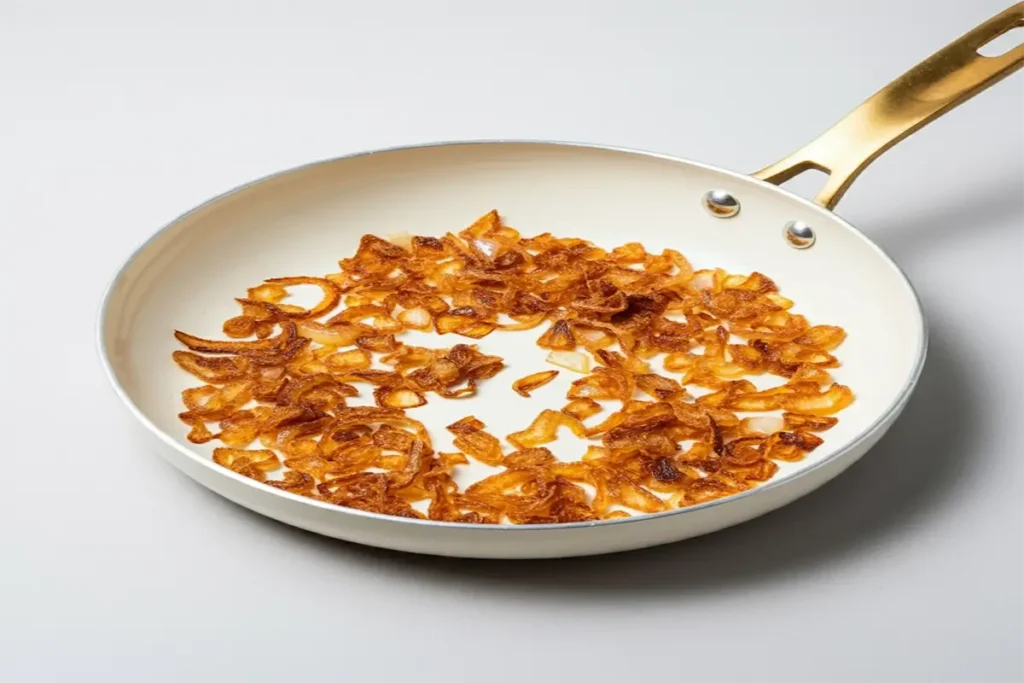
Second Fry – The Transformation
Now, increase the oil temperature to 375°F (190°C). This higher temperature is the key to achieving that coveted golden-brown crust. Carefully add the par-fried potatoes and onions back to the hot oil in batches, again avoiding overcrowding. Fry them for 2-3 minutes, until they transform into beautifully golden brown and irresistibly crispy masterpieces. Remove the fries from the oil and place them on a wire rack to drain any excess oil.
Season and Serve – The Grand Finale
While the fries are still piping hot, season them immediately with additional salt, if desired. This final touch enhances the flavors and adds a burst of savory goodness. Serve your crispy onion French fries immediately and savor the fruits of your labor.
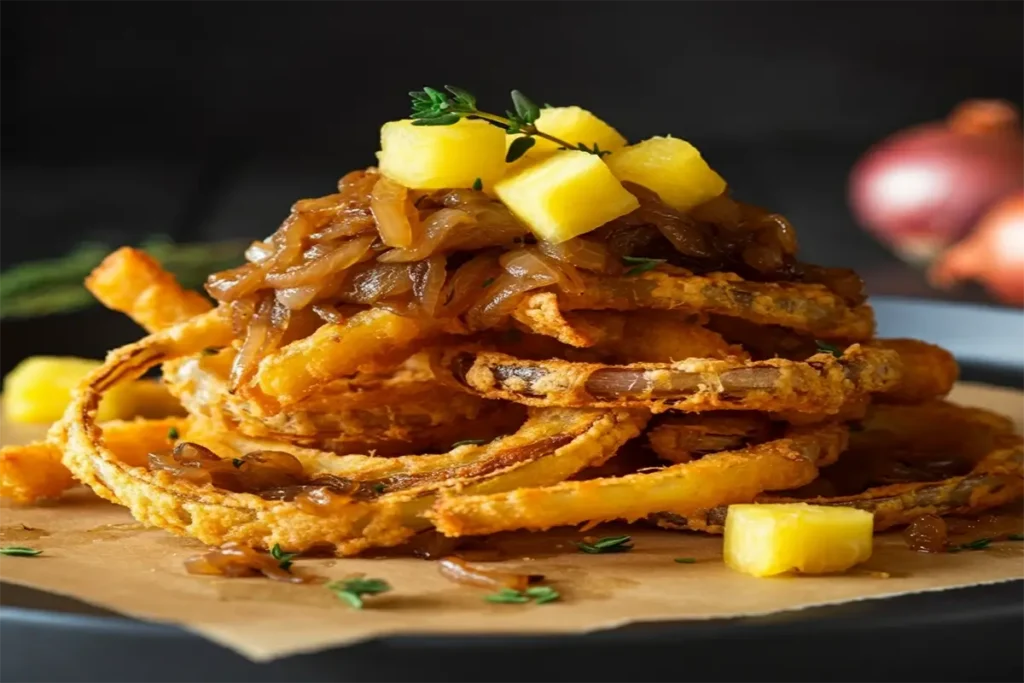
Mastering the Art: Tips for Extra Crispy Onion French Fries
Achieving French fry perfection requires attention to detail and a few insider tips. These insights will elevate your fries from ordinary to extraordinary:
Double Frying is Key
The two-stage frying process is not merely a suggestion; it’s the cornerstone of crispy fries. The first fry cooks the potatoes through, while the second fry creates that irresistible crispy exterior.
Don’t Overcrowd
Overcrowding the pot is a cardinal sin in French fry making. It lowers the oil temperature, resulting in soggy, greasy fries. Fry in batches to ensure each fry receives the proper heat and attention.
Maintain Oil Temperature
Consistent oil temperature is crucial for even cooking and optimal crispiness. Use a thermometer to monitor the oil temperature throughout the frying process and adjust the heat as needed.
Seasoning Options
While the base recipe provides a delicious flavor profile, don’t be afraid to experiment with different seasonings. Onion powder, cayenne pepper, parmesan cheese, or even a sprinkle of herbs can add unique and exciting dimensions to your fries.
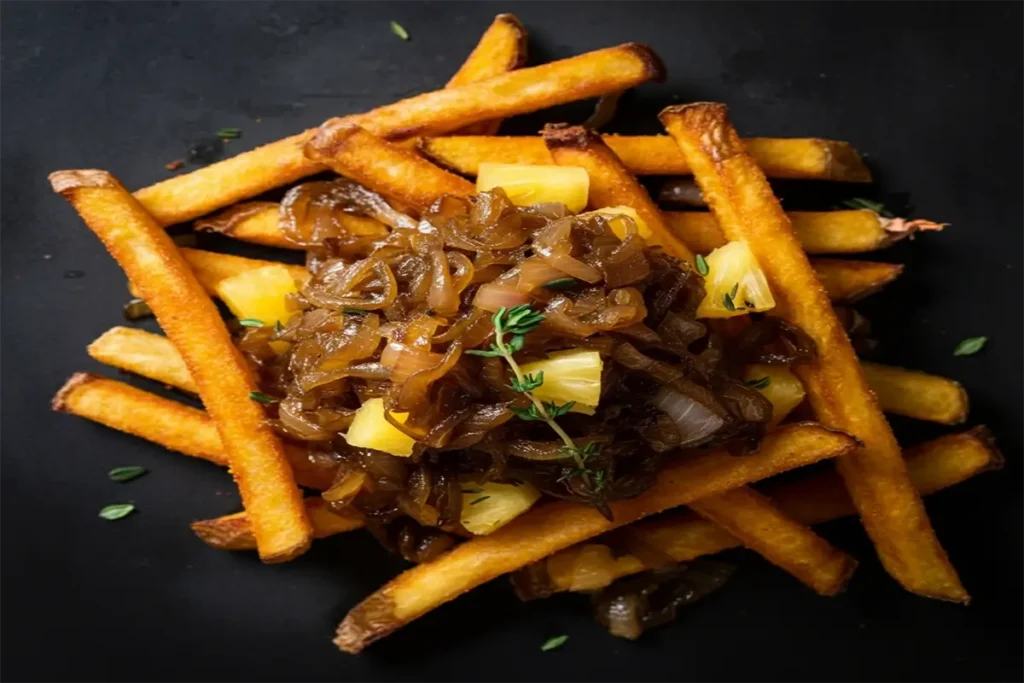
Perfect Pairings: Serving Suggestions
Crispy onion French fries are a culinary chameleon, pairing beautifully with a variety of dips and dishes. Here are a few serving suggestions to inspire your culinary creativity:
Classic Ketchup
You can’t go wrong with the timeless combination of crispy fries and tangy ketchup. It’s a classic for a reason.
Spicy Mayo
For those who like a kick, mix mayonnaise with sriracha or your favorite hot sauce for a fiery dipping experience.
Garlic Aioli
Elevate your fry game with a creamy and garlicky aioli. The richness of the aioli complements the crispy fries perfectly.
Alongside Burgers
Crispy onion French fries are the quintessential side dish for any burger. The combination of juicy burger and crispy fries is a match made in culinary heaven.
Dipping Sauces
Explore a world of flavors with an array of dipping sauces. From smoky barbecue sauce to creamy ranch dressing, the possibilities are endless.

What Oil is Best for Frying?
Frying is a popular cooking method, but choosing the right oil can make all the difference. Whether you’re frying chicken, fish, or even deep-frying a turkey, understanding which oils work best—and at what temperature—can impact the taste, texture, and healthiness of your dish. Let’s dive into the best oils for frying, along with tips for maintaining the right temperature and getting the most out of your frying oil.
1. Key Factors for Selecting the Best Frying Oil
When choosing an oil, three factors are critical: smoke point, flavor, and cost.
- Smoke Point: A high smoke point is essential for frying to avoid burning, which can ruin the flavor and add unwanted toxins to your food. Oils with a smoke point above 350°F are generally preferred for frying.
- Flavor: Some oils have strong flavors that can overpower delicate foods, while others are neutral. Think about whether you want a clean flavor (great for fish) or a richer flavor (great for chicken).
- Cost: For large batches or deep-frying, oil costs can add up. Balancing quality with affordability is important, especially for high-quantity recipes like deep-fried turkey.
2. Best Oil for Frying Chicken
For frying chicken, peanut oil, also known as groundnut oil, is a favorite. It has a high smoke point of about 450°F, making it perfect for frying oil temp for chicken, which should ideally be between 350°F and 375°F. Peanut oil is relatively neutral, letting the chicken’s flavor shine without becoming too greasy. Its heat stability allows for multiple batches without a significant flavor change, making it economical and efficient.
Another great option is canola oil, which has a smoke point around 400°F. It’s a more affordable choice for those making large quantities of fried chicken. Canola oil also has a mild flavor that won’t interfere with seasonings, and its high smoke point means it stays stable at frying temperatures.
3. Best Oil for Fish: The Importance of Temperature Control
Oil temperature for frying fish is critical for achieving a light, crispy coating. Maintaining an oil temp for frying fish between 350°F and 375°F is ideal. Fish cooks quickly, so oils with a high smoke point and a light flavor are best. Peanut oil is an excellent choice due to its stability and mild taste. Canola oil and vegetable oil also work well, offering a more budget-friendly option with a similar smoke point and neutral flavor.
When frying fish, it’s crucial to control the temperature for oil to fry fish consistently. If the oil is too hot, the outside will burn before the inside cooks through. If it’s too cool, the fish can become soggy and oily. Using a thermometer is highly recommended for the best results.
4. Avocado Oil for Frying: A Healthier Option
If you’re looking for a healthier alternative, is avocado oil good for frying? Absolutely. Avocado oil has one of the highest smoke points, reaching up to 520°F, which makes it highly stable at frying temperatures. It’s rich in monounsaturated fats and has a neutral flavor, making it a versatile choice that doesn’t compromise taste.
Avocado oil for frying is especially popular among those focused on health-conscious cooking since it’s less processed and high in antioxidants. However, due to its premium cost, avocado oil may be best reserved for small-batch frying, such as pan-fried dishes, rather than large-scale deep-frying.
5. Groundnut Oil for Frying: Classic and Flavorful
Groundnut oil for frying (also known as peanut oil) is a staple in many kitchens, particularly for Southern and Asian dishes. Its high smoke point, around 450°F, makes it perfect for various frying needs, from fried chicken to tempura. Groundnut oil’s mild, nutty flavor enhances fried foods without overpowering them, and it holds up well under high heat, maintaining its quality through multiple frying batches.
For those frying in bulk or looking to minimize oil waste, peanut oil can be a cost-effective choice. It’s also highly stable, so you don’t have to worry about quick degradation, making it suitable for large-scale frying, such as cooking multiple batches of chicken wings or tempura vegetables.
6. Best Oil for Deep-Frying Turkey: Balancing Cost and Flavor
Deep-frying a turkey requires a significant amount of oil, so finding an affordable option is key. The cheapest oil for deep frying turkey is typically vegetable or canola oil. These oils offer a neutral taste, which won’t interfere with the turkey’s seasoning, and a high smoke point of about 400°F. The ideal temperature for oil to fry fish or poultry (including turkey) is between 350°F and 375°F, which both vegetable and canola oil can handle.
However, if budget allows, peanut oil is a top choice for deep-frying turkey due to its stability at high temperatures. It’s pricier but can be reused several times, so it’s worth considering if you fry often. Always monitor the oil temperature carefully; it should be around 350°F to prevent the turkey from burning on the outside while remaining raw on the inside.
7. Cost Comparison of Popular Frying Oils
Here’s a quick comparison of popular frying oils and their general price ranges:
| Oil Type | Smoke Point | Flavor Profile | Typical Cost |
|---|---|---|---|
| Peanut Oil | 450°F | Mild, nutty | Moderate |
| Canola Oil | 400°F | Neutral | Low |
| Vegetable Oil | 400°F | Neutral | Low |
| Avocado Oil | 520°F | Neutral | High |
| Coconut Oil | 350°F | Distinct, sweet | Moderate-High |
| Olive Oil | 375°F (Light) | Distinct, fruity | High |
This chart can help you decide which oil best fits your frying needs based on your budget and the flavor you want.
8. Temperature Control Tips for Frying
Maintaining the right temperature is key to successful frying, regardless of the oil you use. Here are some quick tips for managing frying temperatures:
Use a Thermometer:
For best results, use a kitchen thermometer to monitor oil temperature. This ensures consistency and helps avoid burning.
Preheat Gradually:
Allow the oil to heat gradually to the target temperature rather than on high heat. This prevents quick breakdown and allows the oil to reach an even heat.
Avoid Overcrowding:
Too much food in the oil at once will lower the temperature quickly, causing soggy, oily results. Fry in batches to maintain a steady temperature.
Let the Oil Reheat Between Batches:
Give the oil a minute or two to return to the desired temperature before adding the next batch.
Conclusion: Choosing the Right Oil for Every Frying Occasion
Selecting the best oil for frying is more than just a preference; it’s a choice that affects flavor, texture, and even health. Peanut oil, with its high smoke point and mild taste, is ideal for classic fried chicken and deep-fried turkey, while avocado oil is a healthier, though pricier, option for lighter frying. Canola and vegetable oils are budget-friendly options suitable for a variety of dishes, including fish, which needs a precise temperature to achieve that light, crisp finish. By understanding the nuances of each oil, you can make informed choices that elevate your frying results every time.
FAQ: Crispy Onion French Fries
Here are answers to some frequently asked questions about making crispy onion French fries:
Can I use other types of potatoes?
While Russet potatoes are the ideal choice for frying due to their high starch content, you can experiment with other varieties like Yukon Gold. However, keep in mind that the results may vary in terms of crispiness and texture.
Can I bake the onion French fries instead of frying?
Baking is a healthier alternative to frying, but it won’t achieve the same level of crispiness. If you opt for baking, toss the coated potatoes with a little oil and bake at 400°F (200°C) for about 20-25 minutes, flipping halfway through.
How do I store leftover onion French fries?
Store leftover fries in an airtight container in the refrigerator for up to 3 days. To restore some of their crispness, reheat them in a preheated oven at 350°F (175°C) for about 10 minutes.
How to make crispy onion french fries with less oil?
For a healthier option that still delivers a good level of crispiness, consider using an air fryer. Follow the manufacturer’s instructions for best results. You can also try shallow frying in a pan with a minimal amount of oil, but be prepared for a slightly different texture.
What’s the best oil for fried chicken?
Peanut oil, due to its high smoke point and neutral flavor, is a top choice for fried chicken. It produces a crispy, golden crust without a greasy finish.
Can I use avocado oil for frying fish?
Yes, avocado oil is excellent for frying fish. Its high smoke point (up to 520°F) and neutral taste make it ideal for a clean, crispy result.
Is groundnut oil good for frying?
Groundnut oil (peanut oil) is great for frying due to its 450°F smoke point and mild, slightly nutty flavor, which works well for a variety of fried foods.
What’s the best temperature for oil to fry fish?
For frying fish, aim for an oil temperature between 350°F and 375°F. This range prevents sogginess and helps achieve a crispy coating.
Conclusion:
With this comprehensive guide, you now possess the knowledge and techniques to create restaurant-quality crispy onion French fries in the comfort of your own home.
No longer do you need to rely on takeout or expensive restaurants to satisfy your craving for these crispy, savory delights.
Embrace the culinary adventure, experiment with different seasonings and dipping sauces, and impress yourself and your loved ones with your newfound fry mastery.
So gather your ingredients, fire up your stove, and prepare to experience the joy of biting into a perfectly golden, crispy onion French fry – a culinary masterpiece crafted by your own hands.
Now, go forth and fry!
